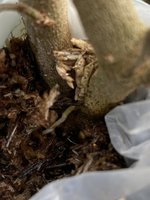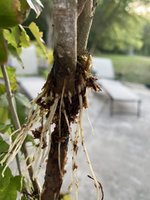My opinion is based on many successfully layers on a number of species. I have found tridents more difficult to layer than JM, most due to bridging. But the bridging I’ve experienced was because the callous on the top and bottom sections (above and below the girdle) got so large that they eventually touched, without forming any roots.
I don’t usually go as deep as you’ve gone, you seem to have nibbled away into the hardwood. I usually just strip the bark and use a knife to scrape any of the remaining fleshy stuff off. Usually when I can see the white hardwood drying and looking “dry” (you have to see it to understand my reference) as I’m working on the layer then I’m confident I’ve taken off everything necessary.
Here’s one of 2 of my failed trident layers, out of about 40 successful layers on many species, including but not limited to:
JM
Trident
Ume
Chojubai
Elaeagnus
Junipers
Zelkova
View attachment 543646





